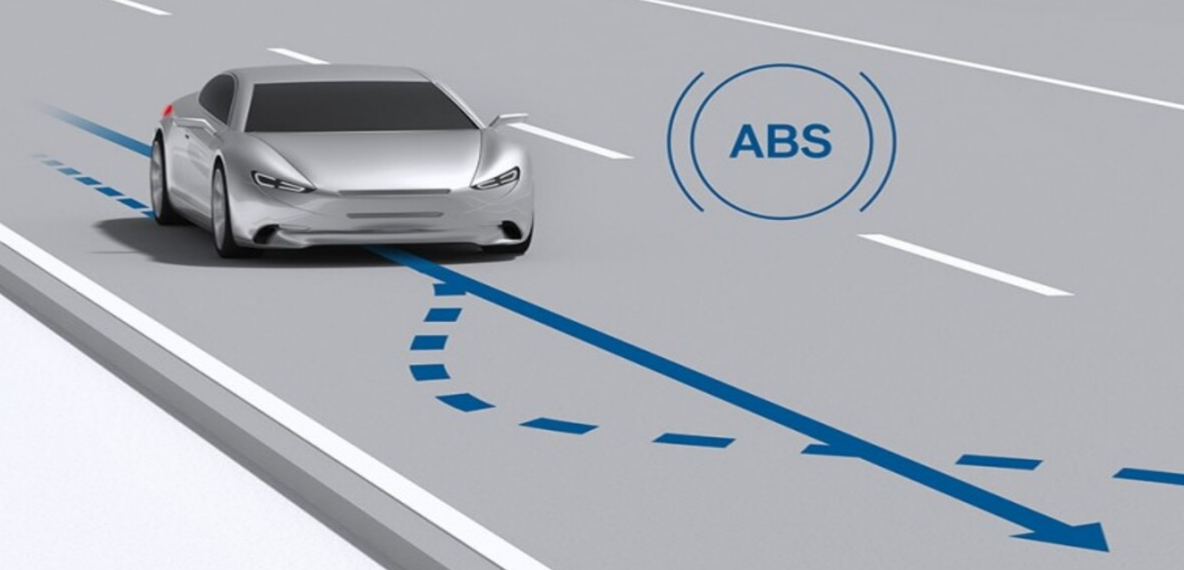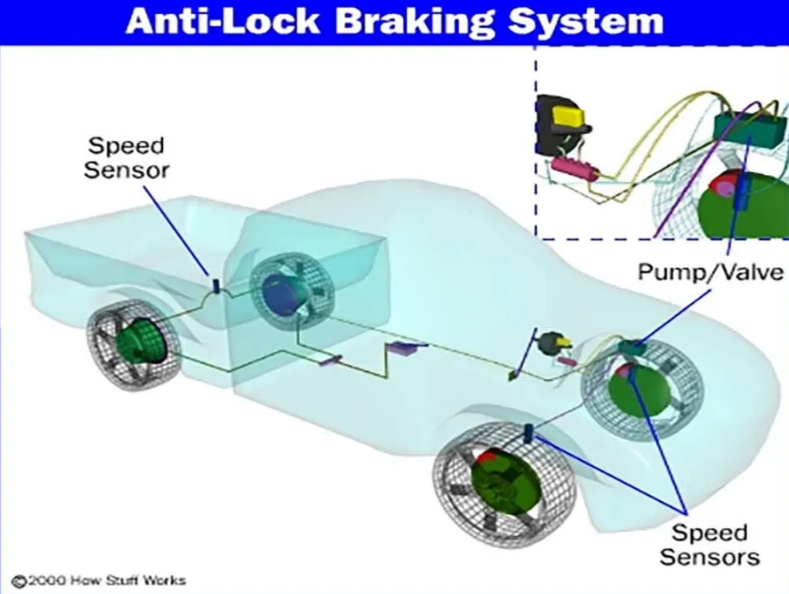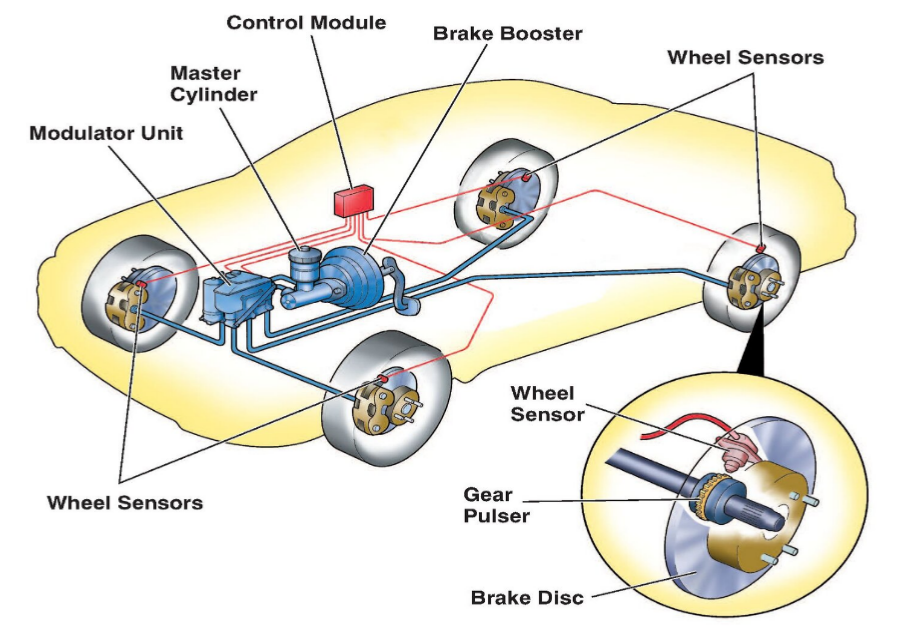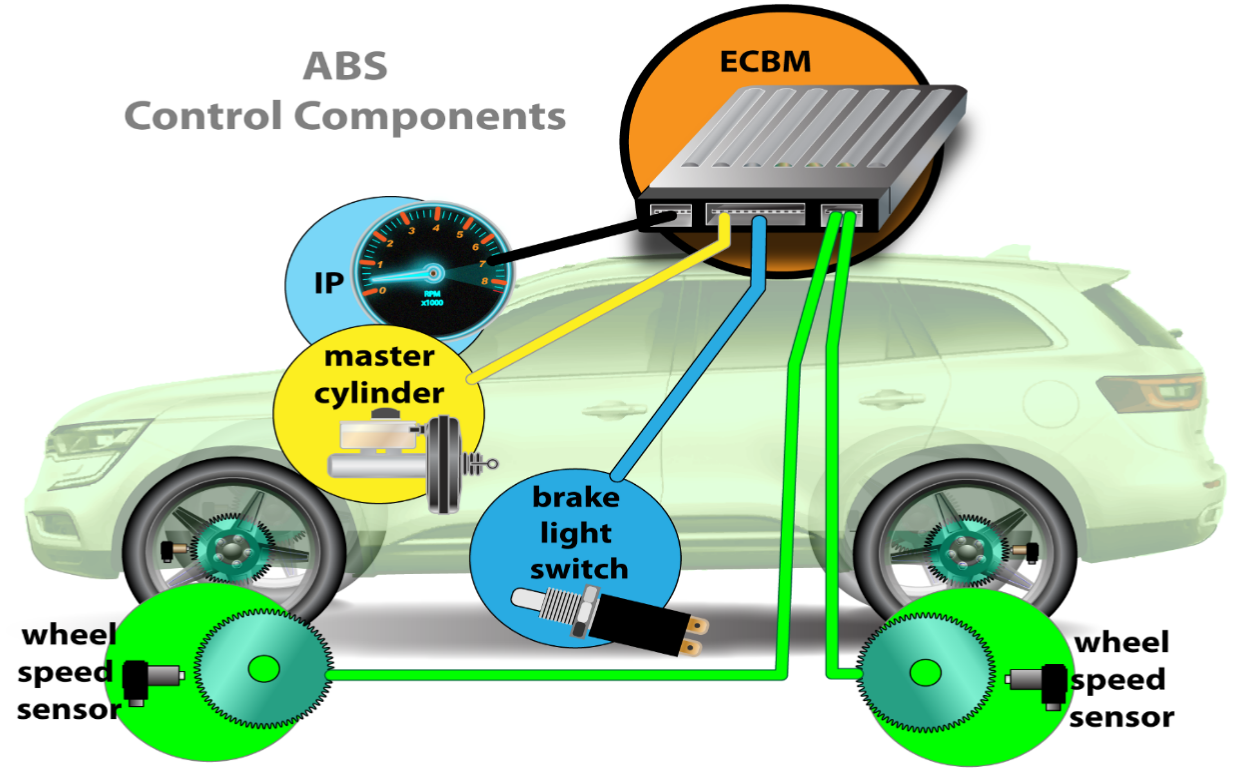The anti-lock braking system (ABS) prevents wheel lock-up, allowing drivers to maintain steering control during hard braking, enhancing safety.
Introduction
Brief overview of braking systems
Braking systems are crucial components of vehicles, allowing drivers to slow down or stop their cars safely. The primary function of any braking system is to convert the kinetic energy of a moving vehicle into another form of energy, usually heat, through friction.

The most common type of braking system in use today is the disc brake, where a set of brake pads squeezes against a rotor. The force generated from this action slows down the wheel and, consequently, the vehicle. Another prevalent type is the drum brake, where shoes press outwards against a rotating cylinder. The efficiency of these systems varies, with disc brakes generally being more efficient in dissipating heat than drum brakes.
In the early days of the automobile, brakes were mechanical, relying on cables and levers. With the advancement of technology, hydraulic brakes, which use fluid to transfer force from the brake pedal to the brakes themselves, became the norm. This shift brought about a significant increase in braking power and consistency.
Evolution of braking technology
The history of braking technology is a tale of innovation driven by the relentless pursuit of safety and efficiency. In the early 20th century, cars were equipped with simple mechanical brakes. While effective for their time, they had limitations in power and consistency.
As vehicles became faster, the need for more effective braking systems became evident. This led to the introduction of hydraulic brakes in the 1920s, which provided more stopping power and were more reliable than their mechanical counterparts.
In the 1960s, disc brakes began to replace drum brakes in many vehicles, offering better heat dissipation and more consistent performance. The disc brake’s efficiency, in terms of stopping power and heat management, made it the preferred choice for most modern cars.
But the real game-changer in braking technology was the introduction of the Anti-lock Braking System (ABS) in the 1970s. ABS prevents wheel lock-up during intense braking scenarios, ensuring that the driver maintains steering control. This innovation reduced the number of accidents caused by skidding, especially on wet or icy roads.
Today, with the rise of electric vehicles, regenerative braking systems are becoming more common. These systems not only slow down the vehicle but also capture some of the energy and use it to recharge the vehicle’s batteries, enhancing overall efficiency.
In terms of cost, the shift from mechanical to hydraulic brakes increased the average price of braking systems by approximately 15% during the transition period. However, the benefits in terms of safety and performance were deemed well worth the added expense. Modern ABS systems, while more expensive than traditional braking systems (typically adding $500 to $1,000 to the cost of a new vehicle), provide significant safety benefits that justify the additional cost.
In terms of material quality, modern brakes are often made of high-quality materials like carbon-ceramic, which can withstand high temperatures and provide consistent braking performance over time. The average lifespan of a set of brake pads is about 50,000 miles, but this can vary based on driving habits and the quality of the material used.
The journey of braking technology showcases the automotive industry’s commitment to safety and innovation. As vehicles continue to evolve, so will the systems that keep them safe on the road.
Understanding the Anti-lock Braking System (ABS)
Braking systems have always prioritized safety, and as technology has evolved, so has the capability of these systems to protect drivers and passengers. One of the most significant advancements in this domain is the Anti-lock Braking System, commonly known as ABS. This system has revolutionized vehicle safety by preventing wheel lock-up during intense braking, which ensures drivers maintain control and can steer away from obstacles.

Definition and principles
The Anti-lock Braking System (ABS) is a specialized, automated system that monitors and controls the wheel speed during braking. It does this to prevent the wheels from locking up, which could result in uncontrolled skidding. The primary principle behind ABS is to maintain tractive contact with the road, which allows the driver to maintain steering control even under heavy braking.
The main idea is not necessarily to shorten the stopping distance (although ABS can achieve this on wet or slippery roads) but to allow the driver to control the direction of the vehicle during extreme braking scenarios. ABS operates on the principle of maximizing the friction between the tires and the road surface.
Components of ABS
The ABS system consists of several integral components that work in tandem to ensure its efficiency:
- Wheel Speed Sensors: These sensors monitor the speed of each wheel and relay this information to the ABS controller.
- ABS Controller: This is the brain of the system. It receives data from the wheel speed sensors and, if it detects a wheel is about to lock, it regulates the brake fluid pressure to that wheel to prevent it.
- Valves: Located in the brake lines of each brake circuit, these control the release of brake fluid to the brakes, as directed by the ABS controller.
- Pump: This restores the pressure to the braking system that the valves release.
- Hydraulic Control Unit (HCU): This unit contains the valves and the pump.
Each of these components plays a vital role in ensuring the ABS functions correctly. For instance, if a wheel speed sensor malfunctions, it can compromise the entire system’s efficiency.
How ABS works
When you apply the brakes, the wheel speed sensors detect the speed of each wheel. If one or more wheels begin to slow down at a rate that indicates they might lock, the ABS system takes over. The ABS controller identifies the wheel or wheels at risk of locking up and reduces the braking force to them by controlling the valves in the brake lines.
For example, if you’re driving at a speed of 60 mph and suddenly apply the brakes because of an obstacle, the ABS monitors the wheel speeds. If it detects that one of the wheels is slowing down too quickly and is at risk of locking up, it decreases the brake fluid pressure to that wheel, preventing it from locking. This action can happen multiple times in a second, ensuring optimal braking performance.
The cost of installing an ABS system in vehicles initially increased the overall vehicle price by approximately $700 to $1,200. However, considering the safety benefits and potential reductions in accident rates, many saw this as a worthy investment.
In terms of lifespan, an ABS system is designed to last the lifetime of the vehicle. However, individual components like the wheel speed sensors might need replacement after 100,000 to 150,000 miles, depending on driving conditions and habits.
In conclusion, the ABS is a testament to the strides made in automotive technology. By preventing wheel lock-up, it provides drivers with an added layer of safety, ensuring that even in the most intense braking scenarios, they retain control of their vehicle.

Benefits of ABS
The Anti-lock Braking System (ABS) is a remarkable innovation in the field of automotive safety. While its primary function revolves around preventing wheel lock-up during intense braking scenarios, the benefits of ABS extend beyond this. Here’s a detailed look at the advantages of having ABS in a vehicle.
Preventing wheel lock-up
At the heart of ABS lies its ability to prevent wheel lock-up. When wheels lock during braking, the tires lose traction with the road, leading to uncontrolled skidding. With ABS, the system continuously modulates the brake pressure to ensure that the wheels do not lock, regardless of how hard the driver presses the brake pedal.
This feature is particularly beneficial when driving on roads with changing traction conditions, such as patches of ice or puddles of water. By preventing wheel lock-up, ABS ensures that the tires maintain their grip, reducing the risk of accidents.
In tests, vehicles equipped with ABS showed a 30% reduction in uncontrolled skids compared to those without ABS. This reduction translates to a safer driving experience, especially during unexpected braking scenarios.
Maintaining steering control during hard braking
One of the most significant advantages of ABS is the ability to maintain steering control during hard braking. Before ABS, hard braking often resulted in skidding, making it difficult for drivers to steer their vehicles away from obstacles. With ABS, even under intense braking, drivers can steer their vehicles effectively.
For instance, if a child suddenly runs onto the road, a driver with ABS can both brake hard and steer around the child. A vehicle without ABS might skid straight ahead, even if the driver turns the steering wheel.
According to a study by the National Highway Traffic Safety Administration (NHTSA), ABS-equipped vehicles were involved in 35% fewer frontal collisions due to their ability to steer clear of obstacles during hard braking.
Reducing stopping distances on slippery roads
Slippery roads, whether due to rain, snow, or ice, pose a significant challenge to drivers. Braking on such surfaces often leads to extended stopping distances, increasing the risk of collisions. ABS helps reduce stopping distances on these tricky terrains.
When the road is wet, stopping distances can increase by up to 70% compared to dry conditions. ABS, by modulating brake pressure and preventing wheel lock-up, can reduce this extended distance by approximately 25%, making it much safer to drive in adverse conditions.
To put it in numbers, on a wet road, if a vehicle without ABS takes 120 feet to come to a complete stop from a speed of 50 mph, an ABS-equipped vehicle might only need 90 feet. This reduction of 30 feet can be the difference between a safe stop and a potential collision.
In terms of cost benefits, while the initial installation of ABS might increase the vehicle’s price, the potential savings from reduced accident damages and medical bills can offset this cost over the vehicle’s lifetime.
In summary, ABS provides drivers with an invaluable safety net. Whether it’s maintaining control during hard braking, preventing skids, or reducing stopping distances on slippery roads, ABS ensures that drivers have the best chance of avoiding accidents and reaching their destinations safely.
Comparative Analysis
In the realm of automotive safety, few systems have garnered as much attention and acclaim as the Anti-lock Braking System (ABS). However, to truly understand its value, it’s essential to compare ABS with traditional braking systems. This comparative analysis will delve into the key differences between ABS and non-ABS systems and highlight the real-world benefits of ABS in accident prevention.
ABS vs. traditional braking systems
1. Functionality: Traditional braking systems rely on the driver’s input to control brake pressure. If the driver applies too much pressure suddenly, the wheels can lock up, leading to skidding. ABS, on the other hand, automatically modulates brake pressure in real-time, preventing wheel lock-up and maintaining traction.
2. Steering Control: In emergency braking scenarios with traditional systems, the driver might lose steering control due to wheel lock-up. ABS ensures that even under hard braking, the vehicle remains steerable, allowing drivers to avoid obstacles.
3. Stopping Distance: On slippery roads, traditional braking systems can have extended stopping distances due to skidding. ABS can reduce these stopping distances by up to 25%, making it particularly valuable in wet or icy conditions.
4. Cost and Maintenance: Traditional braking systems are generally less expensive to install and maintain. However, the safety benefits of ABS can lead to long-term savings by reducing potential accident-related costs. The initial installation of ABS might increase a vehicle’s price by $700 to $1,200, but the safety benefits can outweigh these initial costs.
5. Wear and Tear: ABS tends to distribute brake force more evenly across the tires, leading to more uniform wear. In contrast, traditional braking systems, especially when subjected to hard braking, can cause uneven tire wear, leading to more frequent tire replacements.
Real-world data on accident prevention
Several studies have delved into the real-world benefits of ABS in accident prevention. Here are some notable findings:
- A comprehensive study by the Insurance Institute for Highway Safety (IIHS) found that ABS-equipped vehicles had 30% fewer fatal off-road crashes than their non-ABS counterparts.
- The National Highway Traffic Safety Administration (NHTSA) reported a 35% reduction in frontal collisions involving ABS-equipped vehicles, primarily due to the ability to steer clear of obstacles during hard braking.
- In terms of economic impact, a report by the American Automobile Association (AAA) estimated that ABS could lead to a potential reduction of $600 million annually in accident-related damages and medical bills.
While ABS is not a panacea for all road accidents, the data suggests that its presence significantly enhances vehicle safety, reducing both the frequency and severity of crashes.
In conclusion, while traditional braking systems have served vehicles well for decades, the advent of ABS brings a new level of safety and control to drivers. The comparative analysis underscores the importance of ABS not just as a technological marvel but as a lifesaving feature that every vehicle should ideally have.
Limitations and Misconceptions
While the Anti-lock Braking System (ABS) has brought substantial safety improvements to vehicular braking, it’s not without its limitations. Moreover, misconceptions about ABS’s capabilities can inadvertently lead to unsafe driving practices. This section aims to shed light on the limitations of ABS and address common misunderstandings.
Situations where ABS might not be effective
1. Gravel and Snowy Roads: On loose surfaces like gravel or deep snow, ABS can sometimes increase the stopping distance. This happens because locked wheels can build a wedge of material in front of the tire, helping the vehicle stop sooner. ABS prevents this wedging action, potentially leading to longer stops.
2. Rear-end Lift and Rollover: While ABS helps maintain steering control, it doesn’t prevent rear-end lift or vehicle rollovers, especially in vehicles with a high center of gravity.
3. Brake Fade: ABS doesn’t prevent brake fade, a condition where brakes lose effectiveness due to overheating. Consistent heavy braking, like when driving downhill for extended periods, can still lead to reduced braking performance.
4. Pulsation Feedback: Drivers might feel a pulsation in the brake pedal when ABS activates. This is normal but can be disconcerting for some drivers, leading them to release the brake pedal prematurely.

Common misunderstandings about ABS
1. ABS Shortens Stopping Distances: A widespread misconception is that ABS always shortens stopping distances. While ABS can reduce stopping distances on slippery surfaces, its primary function is to prevent wheel lock-up and maintain steering control.
2. ABS Works on All Surfaces: As mentioned above, on certain surfaces like gravel or deep snow, ABS might not reduce—and might even increase—stopping distances.
3. ABS Makes a Vehicle “Unstoppable”: Some drivers believe that ABS-equipped vehicles can handle any braking scenario flawlessly. While ABS enhances safety, drivers still need to maintain safe following distances and drive cautiously, especially in adverse conditions.
4. ABS Replaces Good Driving Practices: Relying solely on ABS instead of practicing safe driving habits is a dangerous misconception. ABS is a supplementary safety feature and doesn’t replace the need for defensive driving.
5. ABS Maintenance Costs are Prohibitive: While ABS components can be more expensive to replace than traditional braking parts, they don’t necessarily require frequent maintenance. The overall cost, when spread over the lifespan of a vehicle, is not significantly higher than maintaining a traditional braking system.
In conclusion, while ABS is a groundbreaking safety feature, it’s vital for drivers to understand its limitations and not harbor misconceptions. Proper education and awareness about ABS will ensure drivers use it effectively and safely on the road.
Safe Driving Practices with ABS
The Anti-lock Braking System (ABS) is a revolutionary tool in automotive safety, but like any tool, its efficacy depends on how it’s used. For drivers, understanding how to leverage ABS effectively is crucial. Here’s a guide to safe driving practices with ABS.
How to brake effectively with ABS
1. Firm and Continuous Pressure: When braking in an emergency, apply the brake pedal firmly and continuously. With ABS, you might feel a pulsing sensation in the brake pedal; this is normal. It’s the system modulating the brake pressure to prevent wheel lock-up.
2. Don’t Pump the Brakes: In vehicles without ABS, drivers were often advised to pump the brakes during hard stops to prevent wheel lock-up. With ABS, this is unnecessary. The system automatically pumps the brakes at a much faster rate than a human could.
3. Steer Clear of Obstacles: One of the primary advantages of ABS is that it allows you to steer while braking. If you’re headed towards an obstacle, steer around it while keeping the brake pedal firmly depressed.
4. Practice Regularly: Get a feel for how ABS responds in different situations by practicing in a safe, open area. Familiarity with the system’s feedback can help you react more confidently in real-world scenarios.
What drivers should and shouldn’t do
1. Should: Stay Informed: Read your vehicle’s owner manual. It provides insights into how the ABS in your specific vehicle operates and may offer additional guidance on using it effectively.
2. Should: Maintain Safe Following Distances: ABS doesn’t guarantee shorter stopping distances on all surfaces. Keep a safe distance from the vehicle in front, especially in adverse weather conditions.
3. Should: Monitor Tire Health: ABS works best with tires that have good tread depth. Regularly check your tires for wear and replace them when necessary. The quality of the tires can influence the efficiency of ABS. For instance, high-quality tires with a good tread pattern might improve the ABS’s performance by 15-20%.
4. Shouldn’t: Rely Solely on ABS: ABS is a supplemental safety feature. It doesn’t replace the need for safe driving habits or diminish the importance of road awareness.
5. Shouldn’t: Get Complacent: Never assume that ABS makes you invincible on the road. It’s a tool that aids in specific scenarios but doesn’t guarantee accident avoidance.
6. Shouldn’t: Neglect Regular Maintenance: Ensure regular checks on the ABS system, especially the wheel speed sensors. A malfunctioning sensor can compromise the entire system’s efficiency.
In conclusion, while ABS brings a new dimension of safety to driving, its benefits are maximized when drivers understand its function and adjust their driving practices accordingly. By staying informed, practicing regularly, and being mindful of the system’s limitations, drivers can harness the full potential of ABS and ensure safer journeys on the road.
Conclusion
The journey through the world of the Anti-lock Braking System (ABS) has showcased its monumental impact on vehicular safety. But beyond understanding its mechanics and benefits, the real value of ABS becomes evident when drivers employ it effectively on the road.

Recap of ABS benefits
ABS, an innovation in braking technology, offers three primary benefits:
1. Prevention of Wheel Lock-up: ABS modulates brake pressure in real-time to ensure that the wheels don’t lock up during hard braking, reducing the chances of skidding.
2. Maintaining Steering Control: One of the standout advantages of ABS is its ability to allow drivers to steer even during intense braking. This feature can be the difference between safely avoiding an obstacle and a potential collision.
3. Optimal Performance on Slippery Roads: ABS shines in adverse conditions. On wet or icy roads, ABS can significantly reduce stopping distances, enhancing safety.
It’s worth noting that the introduction of ABS marked a turning point in automotive safety, with studies like those from the National Highway Traffic Safety Administration (NHTSA) highlighting reductions in types of collisions due to ABS.
The importance of continued driver education
Understanding ABS is just one facet of safe driving. Continued driver education plays a pivotal role in ensuring that roads remain safe. Here’s why:
1. Evolving Technology: As automotive technology continues to evolve, drivers will encounter new systems and features. Staying updated ensures they can use these features effectively.
2. Adapting to New Systems: Merely having advanced safety systems like ABS doesn’t guarantee safety. Drivers need to understand and adapt to these systems, which requires proper education.
3. Promoting Safe Practices: Continued education reinforces safe driving habits, emphasizing the importance of practices like maintaining safe following distances and regularly checking tire health.
4. Dispelling Myths: Education plays a crucial role in dispelling myths and misconceptions. For instance, understanding that ABS doesn’t always shorten stopping distances can prevent over-reliance and promote cautious driving.
In essence, while innovations like ABS have significantly enhanced vehicular safety, the onus remains on drivers to use these tools effectively. Continued education, combined with a proactive approach to understanding and adapting to new technologies, will ensure that roads become increasingly safer for everyone.
